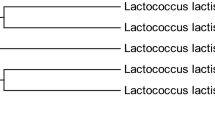Abstract
The bacteriocins of lactic acid bacteria have considerable potential for biopreservation. The Lactococcus lactis strain PSY2 (GenBank account no. JF703669) isolated from the surface of marine perch Perca flavescens produced antibacterial activity against pathogenic and spoilage-causing Gram-positive and Gram-negative bacteria viz. Arthrobacter sp., Acinetobacter sp., Bacillus subtilis, Escherichia coli, Listeria monocytogenes, Pseudomonas aeruginosa and Staphylococcus aureus and possessed broad inhibitory spectrum. The biopreservative efficacy of the bacteriocin PSY2 was evaluated using fillets of reef cod, Epinephelus diacanthus. The fillets (10 g) were sprayed with 2.0 ml of 1,600 AU/ml bacteriocin, wrapped and kept under different storage temperatures viz., 4, 0 and −18 °C. The biopreservative extended the shelf-life of fillets stored at 4 °C to >21 days as against <14 days observed in the untreated samples. The total count of spoilage bacteria was reduced by 2.5 logarithmic units in the treated sample during the 14th day of storage as against the control. Chemical analysis revealed a significant change (P < 0.05) in the pH value, free fatty acid (as % oleic acid), total volatile base nitrogen and total methyl amine content in the treated samples. The overall acceptability in terms of sensory attributes was significantly higher in the bacteriocin-treated samples stored for 21 days at 4 °C while the untreated samples became unacceptable by the 14th day. The biopreservative gave no significant effect at −18 °C. Thus, the bacteriocin derived from L. lactis PSY2 gave increased protection against spoilage bacteria and offers an alternative for the preservation of high-value sea foods.





Similar content being viewed by others
References
Smid, E. J., & Gorris, L. G. M. (2008) In M. S. Rahman (Ed.), Handbook of food preservation, ch.10: natural antimicrobials for food preservation (pp. 237–258). New York: CRC.
Calo-Mata, P., Arlindo, A., & Boehme, K. (2008). Food Bioprocess Technology, 1, 43–63.
Uhlman, L., Schillinger, U., Rupnow, J. R., & Holzapfel, W. H. (1992). International Journal of Food Microbiology, 16, 141–151.
Joshi, V. K., Sharma, S., & Rana, N. S. (2006). Food Technol Biotechnol, 44, 435–439.
Bromberg, R., Moreno, I., Zaganini, C. L., Delboni, R. R., & de Oliveira, J. (2004). Brazilian Journal of Microbiology, 35, 137–144.
Noonpakdee, W., Jumriangrit, P., Wittayankom, K., Zendo, J., Nakayama, J., Sonomoto, K., et al. (2009). Asia-Pac. J. Mol. Biol. Biotechnol., 17, 19–25.
Todorov, S. D., & Dicks, L. M. T. (2007). Brazilian J Microbiol., 38, 166–172.
Akkoc, N., Ghamat, A., & Akcelik, M. (2011). International Journal of Dairy Technology, 64, 425–432.
Food and Drug Administration. (1988). Federal Register, 53, 11247.
Barefoot, S. F., & Klaenhammer, T. R. (1983). Applied and Environmental Microbiology, 45, 1808–1815.
Sarika, A. R., Lipton, A. P., Aishwarya, M. S., Christobel, G. J., & Dhivya, R. S. (2011). The Ecoscan Special Issue, 1, 149–153.
Mailgaad, M., Civille, G. V., & Carr, B. T. (1999). Sensory evaluation techniques. Boca Raton: CRS.
Ke, P. J., Reyier, C. W, Ackman, R. G. (1976). News Series Circular, Fisheries and Oceans. p. 61.
Conway, E. J. (1962). Microdiffusion analysis and volumetric error (p. 467). London: Crosby & Lockwood.
ICMSF. (1986). Microorganisms in foods. Sampling for microbiological analysis: principles and scientific applications (pp. 181–196). Toronto: University of Toronto Press.
Oramadike, C. E., Ibrahim, A. O., & Kolade, O. Y. (2010). actaSATECH, 3, 48–51.
Renitta, R. E., Gnanambal, K. M. E., & Patterson, J. (2006). Asian Fish Sci., 19, 309–317.
Goulas, A. E., & Kontominas, M. G. (2005). Food Chemistry, 95, 511–520.
Poligne, I., & Collignan, A. (2000). Quality Stability Prod. Lebensm-Wiss. u.-Technology, 33, 202–209.
Kilinc, B., & Cakli, S. (2005). Food Con., 16, 639–644.
Shenderyurk, V. I., & Bykowski, P. J. (1990). Salting and marinating fish. In Z. E. Sikorski (Ed.), Seafood: resources, nutritional composition and preservation (pp. 147–162). New York: CRC.
Daramola, J. A., Fasakin, E. A., & Adeparusi, E. O. (2007). African Journal Food Agricultural Nutrition Developmental, 7, 6.
Connell, J. J. (1995). Control of fish quality (4th ed., p. 256). Fishing News Books (Blackwell Science): Oxford.
Brillet, A., Pilet, M.-F., Prevost, H., Cardinal, M., & Leroi, F. (2005). International Journal of Food Microbiology, 104, 309–324.
Sallam, K. I., Ahmed, A. M., Elgazzar, M. M., & Eldaly, E. A. (2007). Food Chemistry, 102, 1061–1070.
Acknowledgments
The authors are thankful to Dr. G. Syda Rao, Director, CMFRI, Cochin and the Scientist-In-charge, CMFRI, Vizhinjam for the facilities provided.
Author information
Authors and Affiliations
Corresponding author
Rights and permissions
About this article
Cite this article
Sarika, A.R., Lipton, A.P., Aishwarya, M.S. et al. Isolation of a Bacteriocin-Producing Lactococcus lactis and Application of Its Bacteriocin to Manage Spoilage Bacteria in High-Value Marine Fish Under Different Storage Temperatures. Appl Biochem Biotechnol 167, 1280–1289 (2012). https://doi.org/10.1007/s12010-012-9701-0
Received:
Accepted:
Published:
Issue Date:
DOI: https://doi.org/10.1007/s12010-012-9701-0




